AMD Athlon 64 FX-57: The Fastest Single Core
by Derek Wilson on June 27, 2005 11:47 AM EST- Posted in
- CPUs
Workstation Applications
SPECviewperf 8SPECviewperf is a collection of application traces taken from some of the most popular professional applications, and compiled together in a single set of benchmarks used to estimate performance in the various applications in which the benchmark is used to model. With version 8, SPEC has significantly improved the quality of the benchmark, making it even more of a real world indicator of performance.
We have included SPEC's official description of each one of the 8 tests in the suite.
3dsmax Viewset (3dsmax-03)
"The 3dsmax-03 viewset was created from traces of the graphics workload generated by 3ds max 3.1. To insure a common comparison point, the OpenGL plug-in driver from Discreet was used during tracing.
The models for this viewset came from the SPECapc 3ds max 3.1 benchmark. Each model was measured with two different lighting models to reflect a range of potential 3ds max users. The high-complexity model uses five to seven positional lights as defined by the SPECapc benchmark and reflects how a high-end user would work with 3ds max. The medium-complexity lighting models uses two positional lights, a more common lighting environment.
The viewset is based on a trace of the running application and includes all the state changes found during normal 3ds max operation. Immediate-mode OpenGL calls are used to transfer data to the graphics subsystem."

CATIA Viewset (catia-01)
"The catia-01 viewset was created from traces of the graphics workload generated by the CATIATM V5R12 application from Dassault Systems.
Three models are measured using various modes in CATIA. Phil Harris of LionHeart Solutions, developer of CATBench2003, supplied SPEC/GPC with the models used to measure the CATIA application. The models are courtesy of CATBench2003 and CATIA Community.
The car model contains more than two million points. SPECviewperf replicates the geometry represented by the smaller engine block and submarine models to increase complexity and decrease frame rates. After replication, these models contain 1.2 million vertices (engine block) and 1.8 million vertices (submarine).
State changes as made by the application are included throughout the rendering of the model, including matrix, material, light and line-stipple changes. All state changes are derived from a trace of the running application. The state changes put considerably more stress on graphics subsystems than the simple geometry dumps found in older SPECviewperf viewsets.
Mirroring the application, draw arrays are used for some tests and immediate mode used for others."
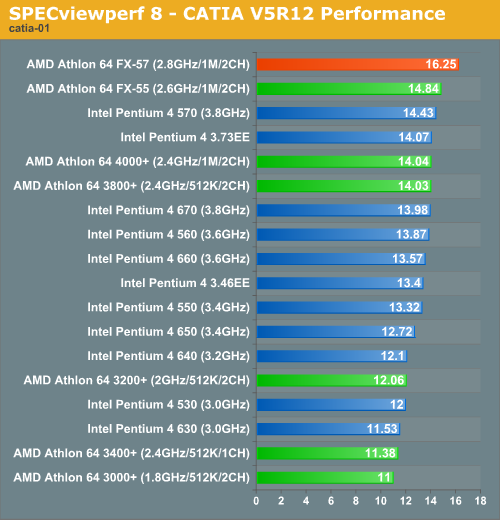
Lightscape Viewset (light-07)
"The light-07 viewset was created from traces of the graphics workload generated by the Lightscape Visualization System from Discreet Logic. Lightscape combines proprietary radiosity algorithms with a physically based lighting interface.
The most significant feature of Lightscape is its ability to accurately simulate global illumination effects by precalculating the diffuse energy distribution in an environment and storing the lighting distribution as part of the 3D model. The resulting lighting "mesh" can then be rapidly displayed."
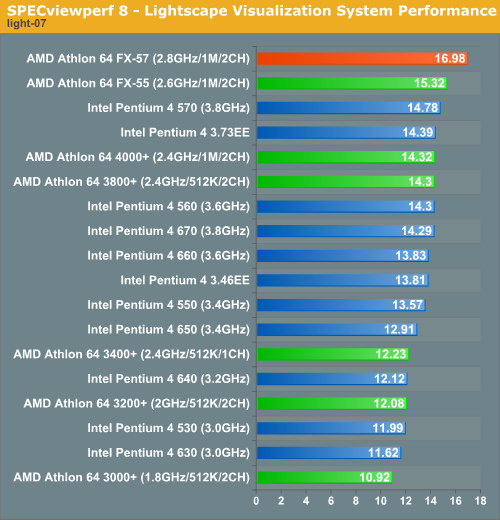
Maya Viewset (maya-01)
"The maya-01 viewset was created from traces of the graphics workload generated by the Maya V5 application from Alias.
The models used in the tests were contributed by artists at NVIDIA. Various modes in the Maya application are measured.
State changes as made by the application are included throughout the rendering of the model, including matrix, material, light and line-stipple changes. All state changes are derived from a trace of the running application. The state changes put considerably more stress on graphics subsystems than the simple geometry dumps found in older viewsets.
As in the Maya V5 application, array element is used to transfer data through the OpenGL API."
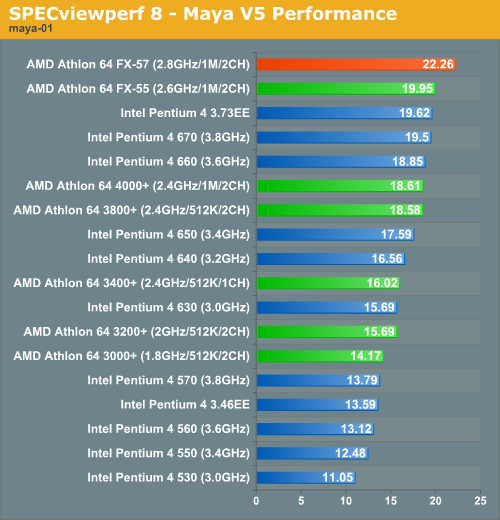
Pro/ENGINEER (proe-03)
"The proe-03 viewset was created from traces of the graphics workload generated by the Pro/ENGINEER 2001TM application from PTC.
Two models and three rendering modes are measured during the test. PTC contributed the models to SPEC for use in measurement of the Pro/ENGINEER application. The first of the models, the PTC World Car, represents a large-model workload composed of 3.9 to 5.9 million vertices. This model is measured in shaded, hidden-line removal, and wireframe modes. The wireframe workloads are measured both in normal and antialiased mode. The second model is a copier. It is a medium-sized model made up of 485,000 to 1.6 million vertices. Shaded and hidden-line-removal modes were measured for this model.
This viewset includes state changes as made by the application throughout the rendering of the model, including matrix, material, light and line-stipple changes. The PTC World Car shaded frames include more than 100MB of state and vertex information per frame. All state changes are derived from a trace of the running application. The state changes put considerably more stress on graphics subsystems than the simple geometry dumps found in older viewsets.
Mirroring the application, draw arrays are used for the shaded tests and immediate mode is used for the wireframe. The gradient background used by the Pro/E application is also included to better model the application workload."
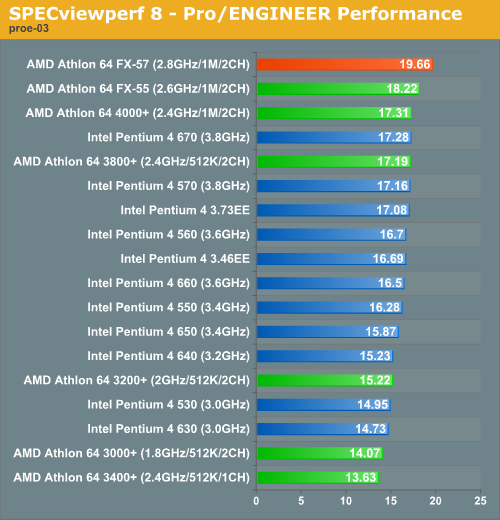
SolidWorks Viewset (sw-01)
"The sw-01 viewset was created from traces of the graphics workload generated by the Solidworks 2004 application from Dassault Systemes.
The model and workloads used were contributed by Solidworks as part of the SPECapc for SolidWorks 2004 benchmark.
State changes as made by the application are included throughout the rendering of the model, including matrix, material, light and line-stipple changes. All state changes are derived from a trace of the running application. The state changes put considerably more stress on graphics subsystems than the simple geometry dumps found in older viewsets.
Mirroring the application, draw arrays are used for some tests and immediate mode used for others."
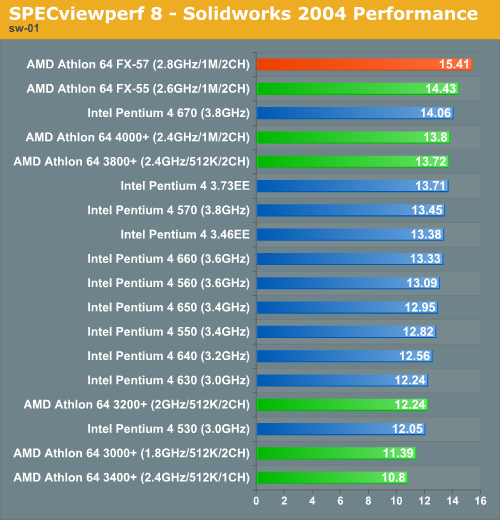
Unigraphics (ugs-04)
"The ugs-04 viewset was created from traces of the graphics workload generated by Unigraphics V17.
The engine model used was taken from the SPECapc for Unigraphics V17 application benchmark. Three rendering modes are measured -- shaded, shaded with transparency, and wireframe. The wireframe workloads are measured both in normal and anti-alised mode. All tests are repeated twice, rotating once in the center of the screen and then moving about the frame to measure clipping performance.
The viewset is based on a trace of the running application and includes all the state changes found during normal Unigraphics operation. As with the application, OpenGL display lists are used to transfer data to the graphics subsystem. Thousands of display lists of varying sizes go into generating each frame of the model.
To increase model size and complexity, SPECviewperf 8.0 replicates the model two times more than the previous ugs-03 test."
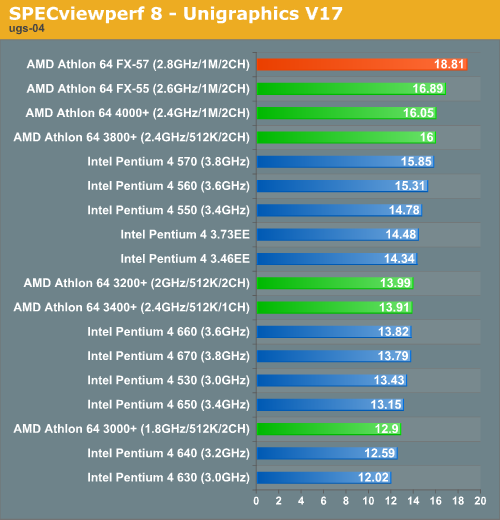










56 Comments
View All Comments
blckgrffn - Wednesday, June 29, 2005 - link
The warranty stops as soon as they changed heatsinks. That's it, that was where it should have stopped evidently ;)Drazula - Tuesday, June 28, 2005 - link
I hate articles like that. You go through the paces of testing and then recommend a solution that wasn't even tested. Why not include a dual core AMD for comparison? As it is, the article is useless.Viditor - Tuesday, June 28, 2005 - link
blckgrffn - "That said, where does it stop?"I would say that you stop where the warranty does...
I.e. no overclocking results except to say it was or wasn't stable at x.x Ghz...Because (as Jarred points out quite correctly) OC can be a very hit and miss proposition.
composer - Tuesday, June 28, 2005 - link
JarredWalton, I get 2.74 stable, air cooling which beats dual opeteron benchmarks, and also runs all the benchmarks stable.We use our PC's for audio, and it seems that even the X2's perform about the same as a single AMD64 overclocked to 2.75 in audio tests (VST plug ins).
Look at this chart:
http://www.adkproaudio.com/benchmarks.cfm
Top graph, it shows the X2 at 58% using 256 samples......we get 58% using AMD 64 overclocked but using the older Nuendo 2.2 version, the newer version Nuendo 3 we get 68% however it's known that the security of the new steinberg program uses 10-15% CPU cycles.
Just some thoughts.
composer - Tuesday, June 28, 2005 - link
L3p3rM355i4h - Tuesday, June 28, 2005 - link
Some one tell me why you would buy a $1000 single core proc, when you could buy a $1000 dual core proc thats going to be soooo much better?ElFenix - Tuesday, June 28, 2005 - link
i've been asking them to get an editor for a long time. at one time, one of them actually replied and asked what kind of editor. i replied that they needed an english editor, and never heard back. they especially need one with some of the newer authors they have.blckgrffn - Tuesday, June 28, 2005 - link
Gotcha, Viditor - but if that is what everyone wants, we should also include the tests done. Yes, I can see how that would have bee a better review, putting say, a 3700+ San Diego and a FX-57 vs each other with all the most expensive goodies and see who came out on top. Heck, SLI some 7800GTX's too, we might as well see how high we can go :)That said, where does it stop? We want to see it under phase, too, with the 7800's oc'ed under chilled water, and some DDR600 @ 2-2-2-10! ;P
AtaStrumf - Tuesday, June 28, 2005 - link
Calin, I meant in terms of overclocking! That's what OC stands for, doh! If you still don't get it, never mind, just know that what I said makes perfect sense ;-)Zebo - Tuesday, June 28, 2005 - link
Hey Tallon:I cdnuolt blveiee taht I cluod aulaclty uesdnatnrd waht I was rdanieg.
The phaonmneal pweor of the hmuan mnid. Aoccdrnig to a rscheearch at
Cmabrigde Uinervtisy, it deosn't mttaer inwaht oredr the ltteers in a wrod
are, the olny iprmoatnt tihng is taht the frist and lsat ltteer be in the
rghit pclae. The rset can be a taotl mses and you can sitll raed it
wouthit a porbelm. Tihs is bcuseae the huamn mnid deos not raed ervey
lteter by istlef, but the wrod as a wlohe. Amzanig huh? yaeh and I
awlyas thought slpeling was ipmorantt.